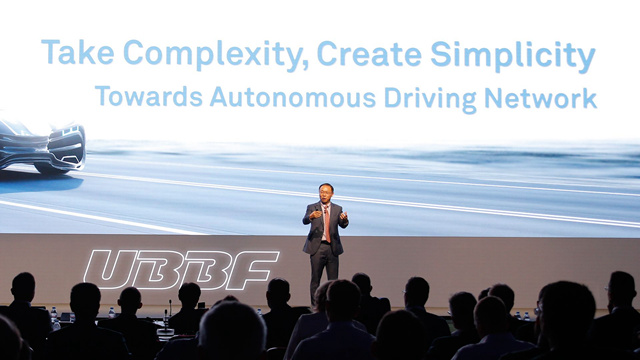|
华为提自动驾驶网络破局电信结构化问题-华为-48v通信高频直流开关电源华为提自动驾驶网络破局电信结构化问题-华为-48v通信高频直流开关电源北京时间9月11日专稿(蒋均牧)在历史发展的滚滚长河中,人类追求先进生产力的脚步从不曾停歇。从最初的手工走向机械化、进而迈向电气化,乃至当前的自动化和智能化,每一次变革都驱动人类社会迈向新的发展纪元。 很多人对自动驾驶的认识还只是科幻片中不真实的镜头,但早在1947年,美国空军就用C54完成了第一次横跨大西洋的全过程自动驾驶飞行的壮举;1983年,法国里尔地铁Métro de Lille启用,成为世界上第一条自动化的地铁路线;2012年,谷歌在内华达州获得世界上第一个无人驾驶的车辆许可,截至2018年3月总里程已经超过800万公里。到今天,特斯拉等汽车的自动驾驶功能已经让很多人享受到了与以往完全不同的舒适、轻松的驾驶方式。 “万物智能时代,自动驾驶正在从理想照进现实,汽车、飞机、制造等领域都在加快迈向自动驾驶的步伐,驱动产业的快速发展升级。而电信领域产业结构化问题突出,网络规模逐年增加,收入的增长落后于OPEX增长。相比OTT行业,电信网络运营维护对人员经验和技能依赖严重,电信网络走向自动驾驶迫在眉睫。”华为常务董事、产品与解决方案总裁汪涛在第五届全球超宽带高峰论坛(UBBF 2018)的主题演讲中旗帜鲜明地说道。
迈向自动驾驶网络迫在眉睫 数字经济下新的价值体系正在重建,电信行业的现状却令人不甚满意。Ovum分析报告显示,过去十年电信行业的收入增长从来没有跑赢过OPEX的增长,产业结构化矛盾日益突出。 一方面,OPEX在电信网络TCO(总体拥有成本)的占比从62%上升到75%,这意味着单纯地降低设备成本,已经不能改善运营商的成本结构;另一方面,相比OTT玩家,电信网络的运营维护严重依赖于人员经验和技能,电信网络平均每1万台设备的运营维护需要300名工程师,而OTT只需要3名工程师,存在100倍的效率差距。 从商业角度出发,“体验为王”的今天,漫长的业务开通时间会使用户失去对购买业务的兴趣;端到端的业务链条中,只要有一环客户不满意,用户就有可能全盘否认这家运营商,特别是在跨行业竞争盛行之下。然而,现实情况则是当前电信网络还存在体验难管理的巨大挑战,有高达58%的家宽用户体验问题是靠用户投诉发现的。 电信行业对自动驾驶网络的需求迫在眉睫。但在硬币的另一面,与汽车产业的自动驾驶不同,电信行业有其自身的复杂性。汪涛指出,一张电信网络同时承载移动、家宽和企业等多种业务,自动驾驶系统需要准确理解不同业务的差异化意图;从自动驾驶的运行环境和路况角度来看,既有数据中心的“高速公路”,又有提供宽带接入的“城乡公路”,需要自动驾驶系统能适应跨多技术领域的复杂环境;从全生命周期运营的角度,电信网络规划、运维、业务发放等不同角色面临的挑战也各不相同。 作为电信行业的重要一员,华为与运营商一起积极进行自动驾驶网络的思考和探索,希望通过架构性的创新,来解决结构性的问题,以帮助客户实现更好的业务体验、更高的运营效率、更高的资源利用率。 首提五级演进标准:逐级递进、小步快跑 自动驾驶网络不再是单个产品的创新,而是系统架构和商业模式的创新,因此,需要产业各方共同定义清晰的标准来牵引技术创新并指导落地。美国汽车工程师协会(SAE)在2014年按照自动驾驶对于汽车操纵的接管程度和驾驶区域,制订了一套自动驾驶分级系统。以此为参考,华为从业务体验和运营效率两个视角,提出了电信行业迈向自动驾驶网络的五级演进标准建议。 L0:手工运维,具备辅助监控能力,所有动态任务都依赖人执行。 “罗马不是一天建成的”,面向自动驾驶网络的演进亦需要分场景逐步推进。华为认为,自动驾驶网络的实施要遵从三大原则——从网络OPEX的主要矛盾切入,从典型运营商的OPEX结构分析可以发现,其中超过50%可以通过自动驾驶网络实现优化;从单领域到跨领域,逐个场景逐步形成闭环系统;同时,要以业务体验为中心,自顶向下构建统一的数据模型和共享能力。 汽车自动驾驶解决的核心难点是传感器和面对各种不确定性的计算处理能力,无论是在高速公路还是乡间小道行驶,都需要车辆能够非常精准的识别周围的环境,并且在极短的时间内作出精准的反应。而电信网络在走向自动驾驶过程中也存在类似的问题。从感知上来看,存在电信网络状态看不清、看不准等问题;从运营运维的角度,离散和封闭的系统导致数据碎片化、流程割裂,跨领域、跨厂商的数据流很难流转并产生价值;同时电信网络的智能化程度不足,对不确定性的决策和处理几乎都需要依赖工程师和专家的经验。 这些困境与挑战如何解决?汪涛指出,电信行业的自动驾驶需要从架构和关键技术层面进行系统性思考和创新,构建三层智能的系统架构。他展开道,首先需要在物理网络层构建一个能实时感知态势的边缘智能层,并通过简化网络架构和协议提升网络自动化执行的能力;其次,通过统一建模在物理网络之上构建一张数字孪生网络,实现全局态势的可回溯和可预测,基于AI实现预测性运维和主动闭环优化;最后,基于开放的云端平台实现AI算法训练和优化,并支撑规划、设计、业务发放、运维保障和网络优化等各类应用的敏捷开发,支撑全生命周期的自动化闭环运营。 把复杂留给自己简单带给客户 “通向自动驾驶网络将是一个长期的旅程,是电信行业的诗和远方,需要产业各方共同努力,坚定前行。华为致力于把复杂留给自己,简单带给客户,共同拥抱万物互联的智能世界。”汪涛在发言中说道。 华为已经在自动驾驶网络领域展开了积极的创新探索。在2018世界移动大会(MWC 2018)上,这家公司正式发布了意图驱动的智简网络(Intent-Driven Network)解决方案,通过在物理网络和商业意图之间构建一个数字孪生世界,驱动网络从SDN网络向自动驾驶网络演进,帮助运营商和企业实现以业务体验为中心的数字化网络转型。 华为智简网络解决方案涵盖宽带接入、IP、光网络、数据中心网络等不同场景,凭借智慧、极简、超宽、开放和安全的特性,将帮助运营商实现四个转变,即从以网络为中心转变为以用户体验为中心、从开环到闭环、从被动响应到主动预测、从依赖经验到自动化和人工智能。以宽带接入领域为例,据统计,全球每1万用户每年平均有1000次客户投诉以及300次上门维护,由于缺乏完整的数据,约有20%的客户投诉无法彻底解决;而通过智简网络可以实现宽带业务体验的实时感知,基于大数据和AI算法快速故障定位和主动优化,减少30%上门,大幅提升最终消费者的服务体验。 与此同时,华为联合全球领先运营商共同发起了NetCity网络创新项目,致力于推动大数据、人工智能、云计算等新技术在电信网络的广泛应用,通过共同定义商业场景、依托DevOps模式开展联合创新,从而实现前沿技术的快速导入,提升最终用户服务体验,推动电信网络走向自动驾驶。 结语 一场以数字化智能化为代表的新变革浪潮汹涌而来,摆在所有人面前的是一个比以往任何时候都要快速变化的时代。作为智能社会底层平台的电信行业正身处变革的中心,无论机会还是挑战,都驱使着运营商必须作出改变。自动驾驶网络及分级系统、目标架构的适时提出,通过系统架构层面的创新以及AI等最新技术的应用,以逐级递进、小步快跑的演进模型,为电信网络转型乃至行业现状的改善提供了有益的思路与参考。“独行快、众行远”,相信在全行业的参与下、在对跨行业技能和经验的学习下,这一演进路径随着时间的推移将会更为完善,而自动驾驶网络所蕴含的价值、所带来的效益亦将越来越多地呈现出来。 In the rolling river of historical development, human beings never stop pursuing advanced productive forces. From the initial manual to mechanization, and then to electrification, and even the current automation and intelligence, every change has driven human society to a new era of development. Many people's understanding of autopilot is still an unreal shot in science fiction movies, but as early as 1947, the U.S. Air Force completed the first full-course autopilot flight across the Atlantic with the C54; in 1983, the Lille Metro de Lille opened, becoming the world's first automated subway line; in 2012, the U.S. Google won the world's first license to drive an unmanned vehicle in Nevada in 2008, with a total mileage of more than 8 million kilometers by March 2018. Today, Tesla and other automotive functions have enabled many people to enjoy a completely different way of driving comfortable and relaxed. "In the age of all things intelligence, automatic driving is coming into reality from the ideal. Automobile, aircraft, manufacturing and other fields are accelerating the pace of automatic driving, driving the rapid development and upgrading of the industry. However, the industrial structure of the telecommunications industry is prominent, the network scale is increasing year by year, and the income growth lags behind the OPEX growth. Comparing with OTT industry, telecom network operation and maintenance rely heavily on personnel experience and skills, so it is imminent for telecom network to move towards automatic driving. Wang Tao, Huawei Managing Director and President of Products and Solutions, said sharply in his keynote speech at the 5th Global Ultra-Wideband Summit Forum (UBBF 2018). Approaching the automatic driving network is imminent. Under the digital economy, the new value system is being rebuilt, and the current situation of the telecommunications industry is not satisfactory. The Ovum analysis report shows that the telecommunications industry has never outperformed OPEX in terms of income growth in the past decade, and the contradiction between industrial structure and industrial structure has become increasingly prominent. On the one hand, OPEX's share of TCO (total cost of ownership) in telecom networks has risen from 62% to 75%, which means that simply reducing the cost of equipment can no longer improve the cost structure of operators; on the other hand, compared with OTT players, the operation and maintenance of telecom networks depend heavily on personnel experience and skills, and the average telecom network is every 10,000. Operating and maintaining equipment requires 300 engineers, while OTT only needs three engineers, there is a 100-fold efficiency gap. From a commercial point of view, "experience is king" today, long business opening time will make users lose interest in purchasing business; end-to-end business chain, as long as there is a ring of customers are not satisfied, users may deny the operator, especially in the prevailing cross-industry competition. However, the reality is that the current telecommunication network still has a huge challenge of difficult experience management, up to 58% of the household breadth user experience problems are found by user complaints. The demand for automatic driving network in telecommunication industry is imminent. But on the other hand, unlike the automobile industry, the telecom industry has its own complexity. Wang Tao pointed out that a telecommunications network at the same time carries a variety of businesses such as mobile, family wide and enterprises. The automatic driving system needs to accurately understand the differential intentions of different businesses. From the perspective of the operation environment and road conditions of automatic driving, there are both "freeway" in the data center and "urban and rural highway" providing broadband access. It is necessary for the automatic driving system to adapt to the complex environment across many technical fields. From the perspective of life cycle operation, the challenges faced by different roles such as telecommunication network planning, operation and maintenance, and business distribution are also different. As an important member of the telecommunications industry, Huawei is actively thinking and exploring with operators on the automatic driving network, hoping to solve structural problems through structural innovation to help customers achieve better business experience, higher operational efficiency and higher resource utilization. First mention of the five level evolution standard: step by step, small step run. Automated driving network is no longer a single product innovation, but a system architecture and business model innovation, therefore, the need for industry parties to jointly define clear standards to tract technological innovation and guide landing. In 2014, the American Association of Automobile Engineers (SAE) developed an automatic driving classification system based on the degree of automotive control and driving area. Taking this as a reference, Huawei puts forward five-level evolution standard proposals for the telecom industry to move towards automatic driving network from the perspective of business experience and operational efficiency. L0: manual operation and maintenance, with auxiliary monitoring capabilities, all dynamic tasks depend on human execution. L1: Assist operation and maintenance, the system repeats a certain sub-task based on known rules to improve the execution efficiency of repetitive work. L2: Partial autonomous network, the system can be based on a certain external environment, a specific unit to achieve closed-loop operation and maintenance, reduce the personnel experience and skills requirements. L3: Conditional autonomous network, based on the ability of L2, the system can sense the change of environment in real time, dynamically optimize and adjust the external environment in a specific field, and realize intent-based closed-loop management. L4: A highly autonomous network. Based on L3's capabilities, the system can achieve predictive or proactive closed-loop management in more complex cross-domain environments for business and customer experience driven networks, solve problems earlier than customer complaints, reduce business interruptions and customer impact, and greatly improve customer satisfaction. L5: Completely autonomous network, which is the ultimate goal of the development of telecommunications networks, the system has a cross-service, cross-domain life 华为通信电源,华为开关电源,华为-48v开关电源,华为高频开关电源,华为直流电源 华为通信电源,华为电源官网,华为高频开关电源,华为-48v开关电源,华为开关电源模块,华为网络机柜,华为服务器机柜,华为室外一体化机柜,华为OLT电源,华为直流电源,华为开关电源,华为综合柜,华为UPS,UPS5000-E,UPS2000-A,UPS2000-G,UPS8000-D,UPS5000-A,华为TP48200,华为TP48300,华为TP48600 |


